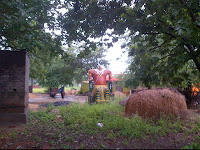Village Gods of the ancient South Indians
One of the most ancient practices employed in South Indian villages was the worship of their gods. Before the Aryan invasion, which probably took place in the second millennium BCE, the Dravidians, who were the original inhabitants with religious beliefs and customs similar to other primitive races. They believed the world to be peopled by a multitude of spirits, good and bad, who were the cause of unusual events, especially disease and disaster .They hoped that through their worship they could propitiate these innumerable spirits . Every village was seen to be under the protection of one spirit or the other, and this spirit was also its guardian deity. Where the family developed into a clan, and the clan into a tribe, and the tribe into a nation, and the nation into a conquering empire, the god of the family naturally developed into an imperial deity. Very similar to the ancient civilizations in Nineveh, Babylon and Egypt where the agricultural communes gradually developed into n

